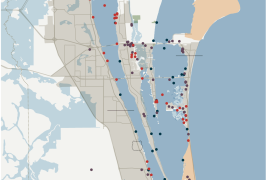For many, life in Florida would seem incomplete without rich green golf courses and lush front lawns. That’s because along with the astronomical population growth the state has seen since 1950 has come the heavy use of fertilizers.
Much of this history has also been marked by the use of septic systems for removing sewage from millions of homes and businesses.
These aspects of Sunshine State living have experts believing that heavy development near the coast and the nitrogen-intensive waste it has generated may be responsible for sudden mass deaths of manatees, dolphins, and pelicans in the Indian River estuary.
As Michael Wines puts it in this New York Times piece, “Now, some experts say, the rapid urbanization of the Florida coast, from the boom years of the space age to the later growth of retirement condos, appears to have pushed the accumulation of those wastes.”
Researchers have observed nitrogen levels that are 45 percent higher than what is considered acceptable in estuary waters off Brevard County. Nitrogen feeds the algae blooms that have replaced the native sea grass and have been found in the intestines of dead manatees that otherwise appeared healthy.
Fertilizer run off is a source of nitrogen as is a build-up of years’ worth of waste from yards and septic systems. A thick muck that has covered the once-pristine sand on the estuary floor, an accumulation of decades of pollutants and nitrogen-rich decayed plant matter,” Wines writes.
Bringing down nitrogen levels in the estuary — and preventing further deaths — is not likely to be quick or easy.
With the sea grass mostly gone, there are few roots to stabilize the nitrogen-heavy muck when winds stir up the waters,” Wines explains. “A switch from septic tanks to sewer systems — and, perhaps, a giant vacuum cleaner — might quickly restore the Brevard waters to health. Otherwise, experts say, recovery seems likely to be a longer, more arduous process.”
[box title=”Author Info” color=”#e0f8d3″]Frank Ferreri, MA, JD, is a legal editor for a publishing company in the West Palm Beach area. He holds degrees in Religious Studies from the University of South Florida and a Law degree from the University of Florida. [/box]


Leave a Reply